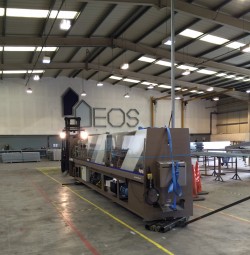The digital age is evolving. We are constantly adapting technology in order to enhance all aspects of the modern world. We have changed the way we socialise, the way we travel and the way we work in order to integrate the latest technology in our everyday lives.
Building Information Modelling (BIM) is at the front and centre of the latest digital technology in today’s built environment. There is now almost a universal recognition of BIM within the construction industry, as well as widespread private sector investment in the implementation of BIM.
So why is BIM so crucial to transforming the industry?
Steve Thompson, MD of EOS Facades, specialists in the design, manufacture and supply of a wide range of steel sections for panelised or volumetric offsite solutions, shares his views on the positive impact that BIM will have on today’s construction industry:
“In terms of procurement, BIM is a powerful tool that allows construction companies to quantify the requirements of their projects. This enables control of spending and time management resulting in the reduction of wastage in these areas. It is essential that BIM is used in the early design stages of a project to ensure that there is capacity to not only clearly identify the elements of the project but through the use of BIM, companies are able to anticipate when they need to procure any given material or element. It is extremely difficult to transport the appropriate knowledge across all construction partners at the same time without the use of BIM, this can lead to the teams procuring the wrong materials at the wrong time, in different volumes.
In 2011 the government committed to the use of 'Level 2' collaborative 3D BIM on all centrally-procured government projects by this year. This is strategically planned as part of a larger overall strategy to combine the use of BIM with the latest modern technology, leading to the collaboration of the government and construction industry working to enhance skills and reduce the cost of infrastructure. The aim of this strategy is ultimately to position digitally enhanced construction as a prerequisite across the UK construction industry.
There has been scepticism, however, from some parts of the industry over the government’s BIM strategy. There seems to be a strong theme of companies claiming that there is a crucial lack of training in this area and that it is too costly and time consuming to invest in, particularly for SME’s.
Despite these claims the overall acceptance that BIM has gained still seems particularly prominent. From my experience, the general consensus from our industry implies that the growing integration of BIM will have a positive effect with only a small percentage of construction companies stating that they will not be using the technology. More money is now being invested in BIM, with large jobs kicking off this year applying the use of BIM in more sophisticated ways than ever before.
I feel that the government’s implementation of BIM Level 2 will have a positive effect on our industry by bringing about progressive changes to the way that we work. Through the execution of this strategy, it is predicted that BIM will bring many employment opportunities, particularly for niche software developers and offsite manufactures, as well as upskilling current employees within our industry. By creating critical mass and certainty of demand, businesses should feel confident when investing in the development of BIM within their companies.
BIM is a key enabler for integrating offsite technology into construction practices – this is something crucial within government projects as there is an acute need for time efficient construction, as well as a vital responsibility for our industry and government to reduce our carbon footprint through the application of low energy buildings – resulting in lower costs for the end user.
BIM helps to provide the platform for teams to integrate and work together, as well as delivering valuable information to confirm that the finished project will meet performance expectations. It is the ideal tool for connecting the whole life cycle analysis of a project – embracing new technology and a new culture of working. This is something that I feel the industry would benefit greatly from and would help to deliver projects with heightened quality through efficiency of communications and accuracy of planning and design. I am eager to see the industry take this advanced method of construction to the next level.”
CPD Factory Tours
To celebrate their tenth anniversary and following the investment in their fifth Howick FRAMA Machine – the first in the UK - EOS Facades have launched a series of CPD Factory Tours at the company’s state of the art facility in County Durham. These tours are FREE to attend and are suitable for architects, contractors, engineers and clients. To find out more visit: www.eos-facades.co.uk/our-services/cpd-accredited-factory-tours/
Building Better with BIM
23rd May, 2016









